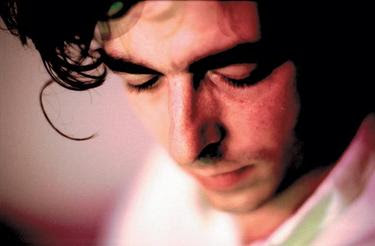Benoît Delbecq Makes Some Noise
This review is an Ionarts exclusive.
The Alliance Française de Washington partnered with the Corcoran Gallery of Art to sponsor a concert by unclassifiable French pianist Benoît Delbecq on Wednesday night. The Corcoran presented Delbecq as a jazz pianist, which he is, but his unusual style of improvisation draws on many other styles and genres, including African traditional, classical, and European experimental. In his hour-long program, Delbecq subjected the Frances and Armand Hammer Auditorium's walnut Steinway to preparation with all manner of foreign objects wedged among the strings. The forest of twigs, eraser pieces, screws, clarinet (and other) reeds, strips with thumbtacks, and other bits of detritus produced sounds like that of pitched drums, cymbals, a sistrum or other rattle, plucked strings, xylophone, and empty thumps and thuds.
Benoît Delbecq, pianist (photo by Roderick Packe)
Delbecq's basic formula is to create an ostinato pattern, generally with the left hand in the lower range of the piano, where the sounds are left pitched but altered to have a faster decay. He then improvises over that pattern, to which rhythmic values can be added or subtracted to relieve the regularity of the ostinato, in the middle range, left unmanipulated to sound like the piano. He then adds accents from time to time in the instrument's upper octaves, where the most percussive alterations have been made. The sonic allusions include the minimalists in the ostinato patterns, John Cage in the preparation of the piano, jazz harmonies in the central piano register (Duke Ellington in a piece called Heptases and a reworking of Thelonious Monk's Misterioso), the whimsy and exoticism of Satie (Oliveira et la Sybille, named after characters in a novel, and Ando-san, a reference to the Japanese architect Tadao Ando).
Another earlier composer who came to mind while hearing these improvisations was Olivier Messiaen, in the dissonant, static color chords at the end of Le sixième sceau (named by analogy to Bergman's The Seventh Seal), which followed bubbling major second clusters that recalled Debussy's prelude Des pas sur la neige (Book 1, no. 6). Yompa, the piece that followed it with no break (which meant changing the preparation bits on the fly), was only one of the improvisations that recalled similar pieces by Fazil Say such as Black Earth, which draws on Turkish folk music. These influences, if they were there, Delbecq did not acknowledge, but he did give a brief description of a pygmy tribe in the central African rain forest, whose chanting inspired his piece Aka. This was not music I would probably choose to listen to again and again, but it was a welcome diversion for an evening.
Benoît Delbecq - piano solo
Uploaded by sextant-revue
The next concert at the Corcoran is the first in the series presented by the Contemporary Music Forum, on Sunday afternoon (September 21, 4 pm).





















































1 comment:
The Corcoran's walnut piano has seen better days. I had hoped it would have been replaced by now...
Post a Comment